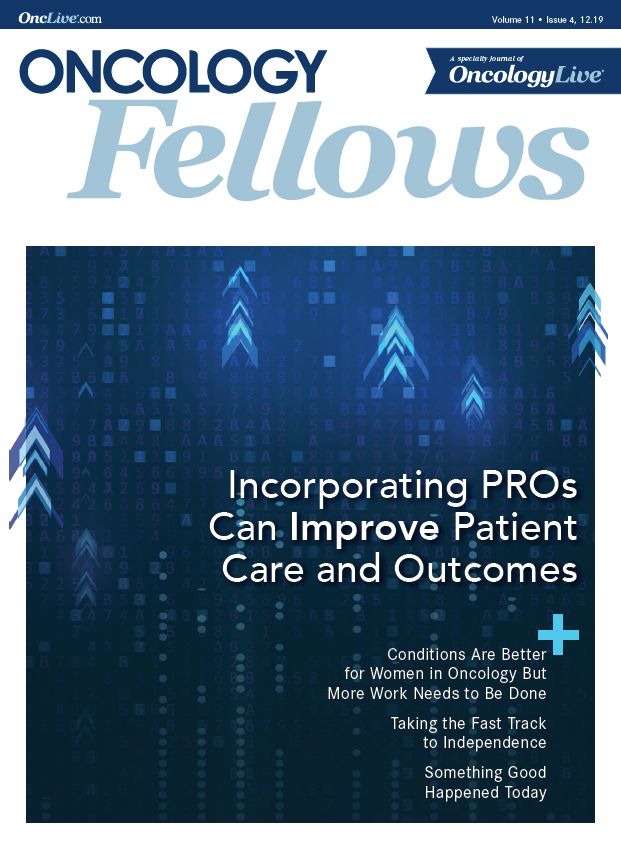Publication
Article
Oncology Fellows
Incorporating PROs Can Improve Patient Care and Outcomes in Oncology
Author(s):
Karnofsky Performance Status and ECOG performance status alone leaves a lot to be desired for the practicing oncologist.
Katie Kerrigan, MD, a hematology/oncology fellow at the University of Utah School of Medicine

Katie Kerrigan, MD
As oncologists, we try to remain both optimistic and realistic in patient care, but clearly, our tendency to “hope for the best and prepare for the worst” may affect our judgment and objectivity. Karnofsky Performance Status (KPS) and ECOG performance status (PS) alone leaves a lot to be desired for the practicing oncologist and as a community, we can improve upon this measurement with the routine incorporation of patient-reported outcomes (PROs).
KPS and PS are physician-synthesized compilations of a patient’s symptoms, self-care ability, symptom burden, and mobility. PS is evaluated at each oncology clinic visit and used as a tool to quantify a patient’s physiologic reserve and level of function. Thus, PS is an important element in routine clinical practice, guiding cancer treatment recommendations and determining eligibility in clinical trials.
Oncologists employ PS rigorously to determine prognosis. Data suggest that an individual’s PS is likely a more accurate prognostic indicator than biologic age, medical comorbidities, or even cancer stage.1
This was nicely demonstrated in a single institution study performed in Canada, where 10 physicians determined ECOG, KPS, and the Palliative Performance Scale scores at the end of an initial consultation for 1655 patients and then developed a simple prognostic model using PS. Survival analyses using the Kaplan-Meier method demonstrated a significant decline in median overall survival (OS) for each worsening performance level, with a median OS of 293, 104, and 25.5 days for ECOG 0, ECOG 2, and ECOG 4 patients, respectively.2
Unfortunately, a static, subjective assessment of a patient in cancer clinic is not likely representative of longitudinal function. Previously published data demonstrated significant interobserver variability in the measurement of PS, with oncologists assigning higher PS scores than patients did at the same time points.3,4
I have experienced this phenomenon in the thoracic oncology clinic during my fellowship. After obtaining what I thought was a thorough clinical history, the patient and I were given the same PS questionnaire. I assigned them an ECOG 1 and they self-assigned an ECOG 2. Incorporating PROs may be a way to address the disconnect in opinion between patient and physician.
In 2004, the National Institutes of Health developed the Patient-Reported Outcomes Measurement Information System (PROMIS) to validate PROs for use in both clinical oncology practice and clinical research. The PROMIS profile domains focus on physical health measures such as fatigue, physical function, pain intensity, pain interference, and sleep disturbance; mental health measures such as anxiety and depression; and social health measures such as the ability to participate in social roles and activities.
Patient self-reported outcomes may more accurately reflect an individual’s physical functioning and wellbeing because they are not subject to physician interpretation and bias, which can occur in a time-limited visit. Previous research demonstrated that incorporating PROs improves physician-patient communication, symptom awareness and management, and patient quality of life.5-7
Additionally, a systematic review found that when PRO measures were routinely collected at the clinic, physicians were more likely to discuss patient outcomes during consultation visits. These discussions facilitated an increased number of supportive care referrals, improvements in patient satisfaction, and improved healthcare usage at end of life.5
Implementation of PROs in the academic oncology practice can reduce emergency department visits and hospitalizations, and may even extend OS.7-10 A single institution study at a tertiary cancer hospital demonstrated the feasibility and success of PRO implementation in 766 patients with advanced cancer.8 Nurses were notified via email if a patient in the PRO intervention group reported a worsening or severe symptom, which resulted in clinical interventions such as new prescriptions, dose modifications, counseling, or referrals for symptom management.
The PRO group participants saw a 5-month improvement in median OS compared with the usual care group (31.2 vs 26 months; P = .03). These findings were both statistically significant in multivariate analysis (HR, 0.83; P = .04) and clinically meaningful.
At Huntsman Cancer Institute, we performed a retrospective pilot study evaluating the 5 PRO domains— physical function, pain interference, fatigue, anxiety, and depression—at a single time point within 6 months of a diagnosis of metastatic melanoma or non—small cell lung, breast, or colorectal cancer.
On multivariate regression, we found that patientreported physical function was strongly correlated with both hospitalization-free survival and OS.11
We can use this information to refer patients with metastatic cancer who report poor physical function to ancillary services such as physical and/or occupational therapy and palliative care services for early intervention. We hope that, given the high economic and emotional costs associated with hospitalization in patients with cancer nearing the end of life, prospective PRO data collection can identify declining patients at an earlier time point so that we may intervene to prevent hospitalization.12
In recent years, there has been a growing interest in PROs within the oncology community. The National Cancer Care Network (NCCN) created a PRO/electronic health record (EHR) work group to develop PRO best practices and implementation strategies. Unfortunately, there have been challenges to incorporating the data into the EHR.
The results of a recently published national survey showed significant practice variation in the specific PRO measures collected, instruments used to gather PROs (66% of PROs were collected on something other than the practice EHR), and timing and frequency of PRO collection.13 At present, the field lacks a complete understanding and a standardized strategy on how to best obtain PRO data and then incorporate it into the clinical workflow for daily use.
Until the oncology community is willing to measure PROs and follow standardized guidelines on implementation, the onus will be on the individual practitioner to collect these data. When available, PROs should be incorporated into the oncologist’s treatment decision making and help guide both referrals to ancillary support services for symptom management and end of life care.
PROs can help support the oncology care provider’s assessment of patient PS to guide treatment decision making, supportive care interventions, and estimations of prognosis. In the future, PROs may supplant PS as the most important prognostic factor in cancer patients. Continued research efforts and buy-in from organizations like the NCCN will be important to develop best practices and confirm the benefit of PRO measurement in the oncology practice.
This article was written by Katie Kerrigan, DO, Hematology & Hematology Malignancies/Oncology Fellow, Huntsman Cancer Institute at the University of Utah.
References
- West HJ, Jin JO. Performance status in patients with cancer. JAMA Oncol. 2015;1(7):998. doi: 10.1001/jamaoncol.2015.3113.
- Jang RW, Caraiscos VB, Swami N, et al. Simple prognostic model for patients with advanced cancer based on performance status. J Oncol Pract. 2014;10(5):e335-e341. doi: 10.1200/JOP.2014.001457.
- Sørensen JB, Klee M, Palshof T, et al. Performance status assessment in cancer patients. An inter-observer variability study. Br J Cancer. 1993;67(4):773-775. doi: 10.1038/bjc.1993.140.
- Ando M, Ando Y, Hasegawa Y, et al. Prognostic value of performance status assessed by patients themselves, nurses, and oncologists in advanced nonsmall cell lung cancer. Br J Cancer. 2001;85(11):1634-1639. doi: 10.1054/ bjoc.2001.2162.
- Velikova G, Booth L, Smith AB, et al. Measuring quality of life in routine oncology practice improves communication and patient well-being: a randomized controlled trial. J Clin Oncol. 2004;22:714-724. doi: 10.1200/JCO.2004.06.078.
- Kotronoulas G, Kearney N, Maguire R, et al. What is the value of the routine use of patient-reported outcome measures toward improvement of patient outcomes, processes of care, and health service outcomes in cancer care? a systematic review of controlled trials. J Clin Oncol. 2014;32(14):1480-1501. doi: 10.1200/ JCO.2013.53.5948.
- Basch E, Barbera L, Kerrigan CL, Velikova G. Implementation of patient-reported outcomes in routine medical care. Am Soc Clin Oncol Ed Book. 2018;38:122-124.
- Basch E, Deal AM, Kris MG, et al. Symptom monitoring with patient-reported outcomes during routine cancer treatment: a randomized controlled trial. J Clin Oncol. 2016;34(6):557-565. doi: 10.1200/JCO.2015.63.0830.
- Basch E, Deal AM, Dueck AC, et al. Overall survival results of a trial assessing patient-reported outcomes for symptom monitoring during routine cancer treatment. JAMA. 2017;318(2):197-198. doi: 10.1001/jama.2017.7156.
- Zhang B, Lloyd W, Jahanzeb M, Hassett MJ. Use of patient-reported outcome measures in quality oncology practice initiative-registered practices: results of a national survey. J Oncol Pract. 2018;14(10):e602-e611. doi: 10.1200/ JOP.18.00088.
- Stukenborg GJ, Blackhall LJ, Harrison JH, Dillon PM, Read PW. Longitudinal patterns of cancer patient reported outcomes in end of life care predict survival. Support Care Cancer. 2016;24(5):2217-2224. doi: 10.1007/s00520-015-3024-y.
- Patel SB, Akerley WL, Ose D, et al. Prognostic value of patient-reported outcomes (PROs) in advanced cancer. J Clin Oncol. 2018;36(suppl 30; abstr 8). doi: 10.1200/JCO.2018.36.30_suppl.8.
- Chastek B, Harley C, Kallich J, Newcomer L, Paoli CJ, Teitelbaum AH. Health care costs for patients with cancer at the end of life. J Oncol Pract. 2012;8(6):75s- 80s. doi: 10.1200/JOP.2011.000469.





















%20(2)%201-Recovered-Recovered-Recovered-Recovered-Recovered-Recovered-Recovered-Recovered-Recovered-Recovered-Recovered-Recovered-Recovered-Recovered-Recovered-Recovered-Recovered.jpg?fit=crop&auto=format)
%20(2)%201-Recovered-Recovered-Recovered-Recovered-Recovered-Recovered-Recovered-Recovered-Recovered-Recovered-Recovered-Recovered-Recovered-Recovered-Recovered-Recovered-Recovered.jpg?fit=crop&auto=format)